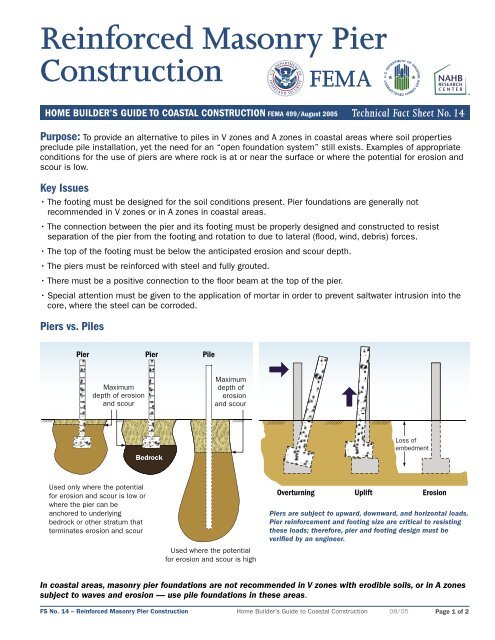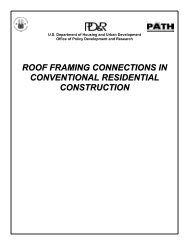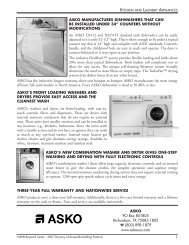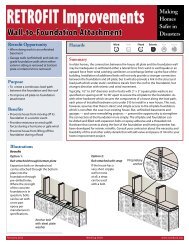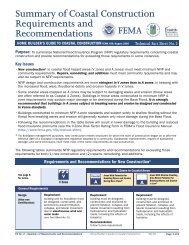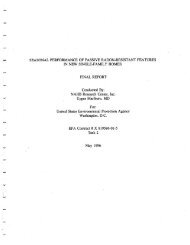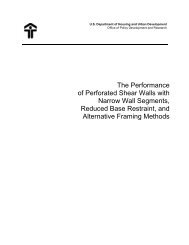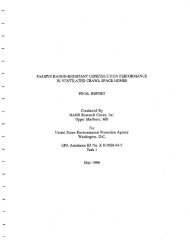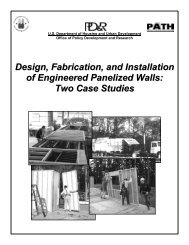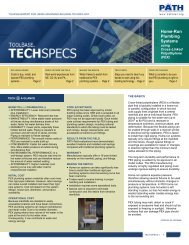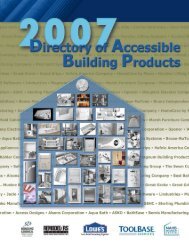Technical Fact Sheet No. 14 Reinforced Masonry Pier Construction
Technical Fact Sheet No. 14 Reinforced Masonry Pier Construction
Technical Fact Sheet No. 14 Reinforced Masonry Pier Construction
You also want an ePaper? Increase the reach of your titles
YUMPU automatically turns print PDFs into web optimized ePapers that Google loves.
<strong>Reinforced</strong> <strong>Masonry</strong> <strong>Pier</strong><br />
<strong>Construction</strong><br />
HOME BUILDER’S GUIDE TO COASTAL CONSTRUCTION FEMA 499/August 2005 <strong>Technical</strong> <strong>Fact</strong> <strong>Sheet</strong> <strong>No</strong>. <strong>14</strong><br />
Purpose: To provide an alternative to piles in V zones and A zones in coastal areas where soil properties<br />
preclude pile installation, yet the need for an “open foundation system” still exists. Examples of appropriate<br />
conditions for the use of piers are where rock is at or near the surface or where the potential for erosion and<br />
scour is low.<br />
Key Issues<br />
• The footing must be designed for the soil conditions present. <strong>Pier</strong> foundations are generally not<br />
recommended in V zones or in A zones in coastal areas.<br />
• The connection between the pier and its footing must be properly designed and constructed to resist<br />
separation of the pier from the footing and rotation to due to lateral (flood, wind, debris) forces.<br />
• The top of the footing must be below the anticipated erosion and scour depth.<br />
• The piers must be reinforced with steel and fully grouted.<br />
• There must be a positive connection to the floor beam at the top of the pier.<br />
• Special attention must be given to the application of mortar in order to prevent saltwater intrusion into the<br />
core, where the steel can be corroded.<br />
<strong>Pier</strong>s vs. Piles<br />
<strong>Pier</strong>s are subject to upward, downward, and horizontal loads.<br />
<strong>Pier</strong> reinforcement and footing size are critical to resisting<br />
these loads; therefore, pier and footing design must be<br />
verified by an engineer.<br />
In coastal areas, masonry pier foundations are not recommended in V zones with erodible soils, or in A zones<br />
subject to waves and erosion — use pile foundations in these areas.<br />
FS <strong>No</strong>. <strong>14</strong> – <strong>Reinforced</strong> <strong>Masonry</strong> <strong>Pier</strong> <strong>Construction</strong> Home Builder’s Guide to Coastal <strong>Construction</strong> 08/05 Page 1 of 2
<strong>Pier</strong> foundations are most<br />
appropriate in areas where:<br />
• erosion and scour potential<br />
are low,<br />
• flood depths and lateral<br />
forces are low, and<br />
• soil can help resist<br />
overturning of pier.<br />
The combination of high winds<br />
and moist (sometimes saltladen)<br />
air can have a damaging<br />
effect on masonry construction<br />
by forcing moisture into<br />
even the smallest of cracks<br />
or openings in the masonry<br />
joints. The entry of moisture<br />
into reinforced masonry<br />
construction can lead to<br />
corrosion of the reinforcement<br />
The small footings on the piers in this photograph did not prevent these piers<br />
steel and subsequent cracking<br />
from overturning during Hurricane Iniki.<br />
and spalling of the masonry.<br />
Moisture resistance is highly<br />
influenced by the quality of the materials and the quality of the masonry construction at the site.<br />
Good <strong>Masonry</strong> Practice<br />
• <strong>Masonry</strong> units and packaged mortar and grout materials should be stored off the ground and covered.<br />
• <strong>Masonry</strong> work in progress must be well protected.<br />
• Mortar and grouts must be carefully batched and mixed. The 2003 International Building Code (IBC 2003)<br />
specifies grout proportions by volume for masonry construction.<br />
Recommendations for <strong>Masonry</strong> <strong>Pier</strong>s in Coastal Regions<br />
FS <strong>No</strong>. <strong>14</strong> – <strong>Reinforced</strong> <strong>Masonry</strong> <strong>Pier</strong> <strong>Construction</strong> Home Builder’s Guide to Coastal <strong>Construction</strong> 08/05<br />
Page 2 of 2


